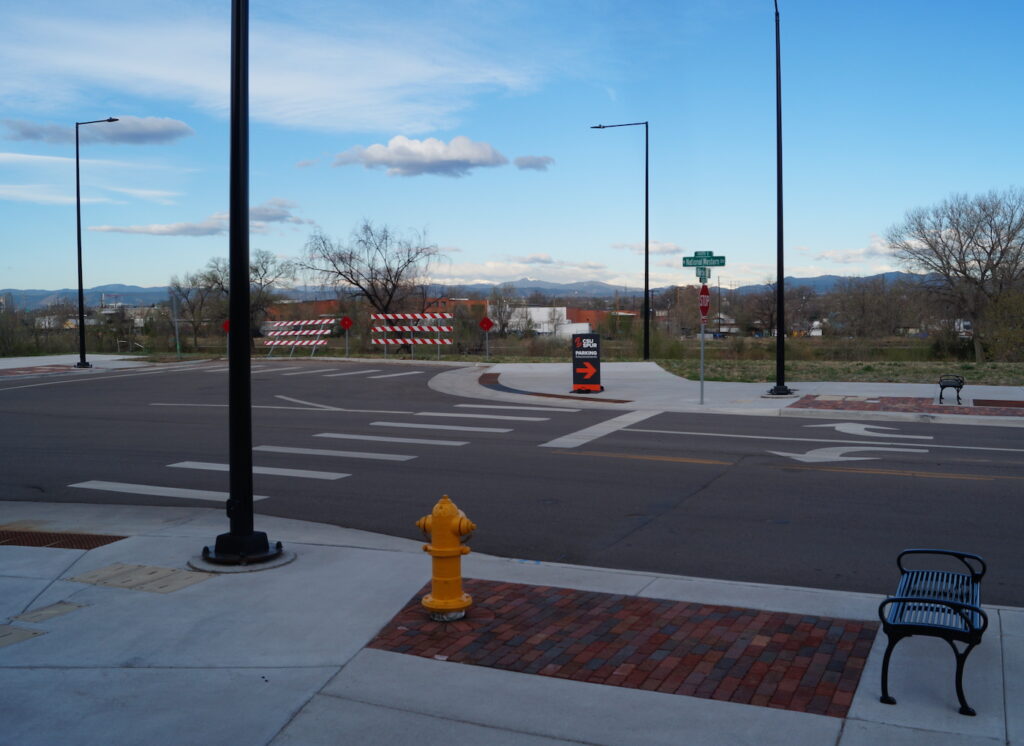By Kathryn White

In March, Mayor Mike Johnston announced that the neighborhoods of Globeville and Elyria-Swansea had been selected for a $35.5 million federal Reconnecting Communities and Neighborhoods (RCN) grant from the U.S. Department of Transportation (USDOT).
Funds will go toward four transportation infrastructure projects in and around the National Western Center and CSU Spur campuses. They include: 1) the construction of a bridge and greenway corridor over the South Platte river between CSU Spur and 48th Avenue; 2) a pedestrian bridge between National Western’s Stockyards Event Center and the 48th and Brighton RTD station, which services the N Line; 3) improvements to a pedestrian-level rail crossing on National Western Avenue near East 46th Avenue; and 4) environmental remediation on a former landfill site, since paved over and used for other purposes, between 48th and 49th on the west side of Brighton Boulevard.
An additional $32.4 million will be needed for the projects. They are projected to enter a two-year construction phase in 2025 and will cost an estimated $67.9 million.
On March 21, to punctuate the funding announcement, Mayor Johnston hosted Second Gentleman Douglas Emhoff (Vice President Kamala Harris’ husband) and Tom Perez, a senior advisor to President Joe Biden, for a bus tour of the CSU Spur and National Western areas where the projects are to take place. They ended the outing with a press conference at Argo Park in Globeville.
“This is life-changing work that you have just allowed to occur,” Brad Buchanan, CEO of the National Western Center Authority, said to Emhoff and Vigil as the bus tour began.
Buchanan went on to describe the industrial history of the area – from smelters to stockyards – and the ways residents have, since the early 1900s, been separated from public resources and amenities.
“And what comes along with all those kinds of [industrial] uses?” Buchanan said. “Tons of infrastructure. It’s rail. It’s river. It’s highways. Most of which were placed in these underserved communities who didn’t have a voice. They couldn’t fight back. They really didn’t get a vote in the decisions.”
“Construction of I-70 and I-25 have further divided the neighborhoods,” said Caroline Acha, a Globeville resident and board member with Tepeyac Community Health Center, at the Argo Park press conference.
“Globeville has had a history of disinvestment that led to the problems that we face today,” added Acha, who also serves as one of two community representatives on the 13-person National Western Center board. “Industry and car-centric infrastructure here has resulted in one of the most polluted ZIP codes in the United States. The detrimental effects of this have impacted the health of local families for decades. But with these grant funds, infrastructure improvements will create better walkability and connectivity, a priority for residents who don’t drive. Reducing impacts of pollution is essential in a neighborhood where residents have been experiencing negative health effects for decades.”
Mayor Johnston wanted to thank community members and leaders “who have been pushing and pushing, and fighting and fighting, for years and decades to make sure that Globeville got the resources that it deserved.”
“Today is the day that the White House heard you,” Johnston continued. “Today is the day the White House said, ‘We see Globeville. We see the opportunity and we will not stand by and do nothing.’”
Councilman Darrel Watson, who represents Globeville and Elyria-Swansea on Denver City Council, said that the infrastructure projects, especially the remediation at 48th and Brighton, will help pave the way for continued collaboration between the city and the local community around the future of what has become known as The Triangle.
Harmony Cummings of the Green House Connection Center in Elyria-Swansea said her organization was not made aware of the press event and bus tour. But Cummings, who has served on city advisory boards and is actively involved in environmental justice advocacy, led a “walk and roll tour” with area residents in January to uncover community interests around what she described as pedestrian dignity.
“No one in the community has ever said that these items are their priorities,” Cummings said of the four RCN projects. Instead, Cummings said, she hears community members talking about sidewalks and bike lanes, things that take them to places they want to go, which are typically not CSU Spur and the National Western Center.
Cummings described the funding as “taxpayers subsidizing developers through infrastructure projects.”
According to a USDOT factsheet on the grant program, $3.3 billion overall was awarded to 132 communities for RCN projects. It went on to state that RCN intends to improve daily access to jobs, education, healthcare, food and recreation; to foster equitable development and restoration; and to reconnect communities that have lost connectivity, mobility or economic development as a result of being disconnected by transportation facilities.

Be the first to comment